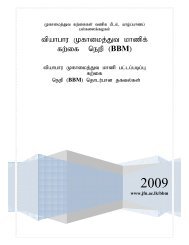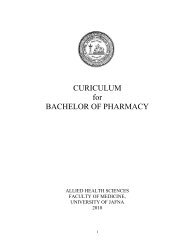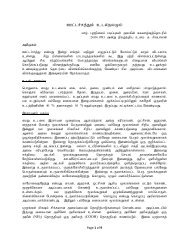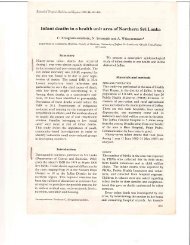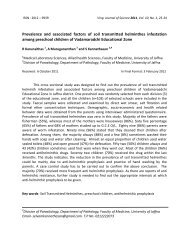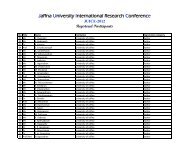MANUAL PHYSIOLOGY PRACTICAL - Repository:The Medical ...
MANUAL PHYSIOLOGY PRACTICAL - Repository:The Medical ...
MANUAL PHYSIOLOGY PRACTICAL - Repository:The Medical ...
You also want an ePaper? Increase the reach of your titles
YUMPU automatically turns print PDFs into web optimized ePapers that Google loves.
FM/UOJ<br />
Experiment 2.4<br />
Measurement of intra ocular pressure<br />
<strong>The</strong> aqueous humour of the eye is formed by the ciliary body, flows through the<br />
pupil and absorbed into the canal of Schlemm and from there to the venous plexus. <strong>The</strong><br />
circulation of this fluid provides the pressure in the eye which helps to keep the spherical<br />
structure. When the formation is reduced as in severe dehydration the pressure reduces<br />
and when the drainage is affected as in glaucoma, the pressure increases.<br />
<strong>The</strong> pressure can be clinically judged by pressing the eyeballs over the eyelid. <strong>The</strong><br />
same principle is use to measure the pressure more precisely by a Tonometer.<br />
Experiment 2.5<br />
Visual acuity<br />
<strong>The</strong> degree to which the details and contours of objects are perceived is the visual<br />
acuity. It is usually defined by the minimum separable distance between two lines. It is<br />
the shortest distance between two lines which can be identified as two lines. Defects in<br />
visual acuity may occur due to neural or refractive errors.<br />
Snellen chart<br />
Snellen chart is commonly used to test visual acuity. <strong>The</strong> letters on it are prepared<br />
so that the width of the lines in the letter subtend 1 minute arc and the minimum distance<br />
between the lines is also 1 minute and the width of the whole letter subtends 5 minute arc<br />
from the distances marked below them. An individual with normal visual acuity could<br />
read the first row of letters from a distance of 60 meters (200 feet). Similarly, the row of<br />
letters marked 6 meters (20 feet) could be read from that distance.<br />
Method:<br />
<strong>The</strong> snellen chart is placed at the eye level and illuminated well. <strong>The</strong> subject is<br />
placed 6 meters (20 feet) from the chart. One eye is blind folded. <strong>The</strong> subject is asked to<br />
read from top. <strong>The</strong> last line that is clearly read is noted. <strong>The</strong> procedure is repeated for the<br />
other eye.<br />
<strong>The</strong> visual acuity is determined by dividing the distance from which the chart is<br />
read by the distance from which a normal person can read the last row read by the subject.<br />
If the subject has read the row marked 6 meters, his visual acuity is 6/6 (or 20/20). If the<br />
subject read up to the row marked 18 meters, the acuity is 6/18- less than normal. If the<br />
subject goes on to read the row marked 5 meters, then the acuity is 6/5 which is better<br />
than normal.<br />
If the visual acuity of the subject is reduced, the test is repeated allowing the<br />
subject to read through a pin hole. <strong>The</strong> pin hole eliminates the function of the refractive<br />
mechanisms and the performance improves if the subject had refractive error. If the<br />
reduction of visual acuity was due to neural problems, pin hole does not improve the<br />
acuity.<br />
Neurology<br />
Page | 147




